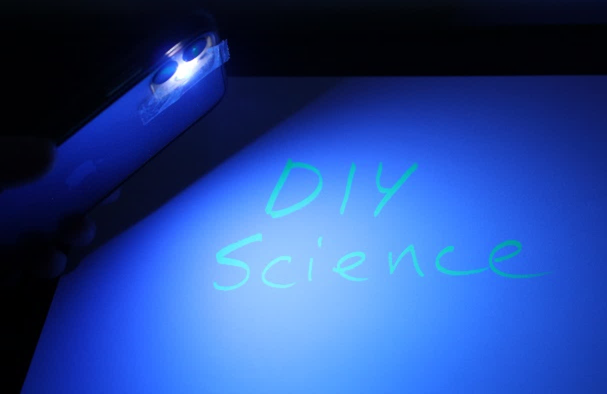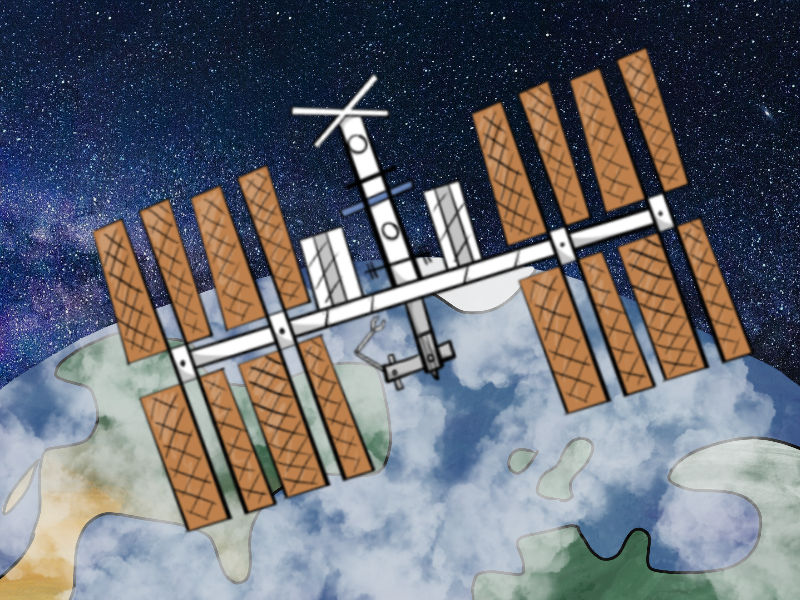DIY Science
Science projects to try at home, especially if you can't get out and about

DIY Science 2024
Daily updates
Come back every day during National Science Week to see the daily DIY activities!
- Saturday 10 August: Acidic Oceans (Chemistry, climate change)
- Sunday 11 August: Secret Sounds (Physics, sound waves, anatomy)
- Monday 12 August: Mini Greenhouse (Biology, agriculture)
- Tuesday 13 August: Suspended Bubbles (Chemistry, buoyancy, states of matter)
- Wednesday 14 August: Marshmallow Launcher (Physics, mechanics, design thinking)
- Thursday 15 August: Make a Magnet (Physics, magnets, electronics)
- Friday 16 August: Rainbow Lightning (Physics, fluids, art)
- Saturday 17 August: Water Density (Earth science, temperature, fluids, density)
- Sunday 18 August: Storm in a Jar (Earth and space science, physics)
Activity sheets
Download all of the 2024 activity sheets (2.0 MB, zip) listed below. With thanks to Jenny Lynch from Creative Science for these activities.
- Build a Black Light
Find and test fluorescent materials using a makeshift UV light made from a torch or your smart phone!
Download now (File size: 309 KB, pdf)
- Wonderful Worms
Test how earthworms search for food, churn the soil, and hide from light.
Download now (File size: 475 KB, pdf)
- Smartphone Sound Meter
Explore how to get reading on the loudness of sounds.
Download now (File size: 307 KB, pdf)
- Making Bush Glue
Experience Aboriginal toolmaking through the creation of ‘bush glue’ using natural resin.
Download now (File size: 685 KB, pdf)
- Growing Crystals
Grow your own sparkling crystals and explore crystal structure.
Download now (File size: 321 KB, pdf)
More DIY Science
Other National Science Week contributors have DIY activities to try too - check out these ones from:
DIY Science 2023
Daily updates
- Sunday 13 August: Strawberry DNA Extraction (biochemistry)
- Monday 14 August: Water Bottle Pinhole Prank (surface tension and atmospheric pressure)
- Tuesday 15 August: Erasable Pens (thermochromic ink)
- Wednesday 16 August: Magic Coin Trick (heat conductivity)
- Thursday 17 August: Gelatine Colour Diffusion (molecular transport in a gel)
- Friday 18 August: Homopolar Electric Motor (electromagnetism - Lorentz force)
- Saturday 19 August: Fruit Juice Caviar (specific density, immiscible liquids and gels)
Activity sheets
Download all of the 2023 activity sheets (2.2 MB, zip) listed below. With thanks to Jenny Lynch from Creative Science for these activities.
Light Fountain
How can you trap a laser beam in a stream of water? Total internal reflection is used to transmit light in fibre optics, but light can also be steered by water.
Download now (519 kB, pdf)
Enzymes in Action
Enzymes are probably mentioned on your clothes washing powder package, but did you know you also have enzymes in your mouth? Enzymes are catalysts - chemicals that speed up chemical reactions without being consumed.
Download now (885 kB, pdf)
Thoughtful Fun With Fire
What can you observe in a candle flame? Once that is done, can you relight a candle from a distance? Or extinguish the flame by pouring on some carbon dioxide gas?
Download now (412 kB, pdf)
Sunny Survival
Use the Sun to distil water and measure the time until sunset and use the stars to navigate.
Download now (554 kB, pdf)
DIY Science 2022
Daily updates
- Saturday 13 August: Tablecloth Trick (inertia)
- Sunday 14 August: Rock Candy (crystalline sugar)
- Monday 15 August: Electrical Currency (electrical cells)
- Tuesday 16 August: Pen Lid in a Bottle Challenge (air pressure and fluid flows)
- Wednesday 17 August: Edible Slime (starch gelification)
- Thursday 18 August: Brazil Nut Challenge (granular convection)
- Friday 19 August: Arm Span Solar System (astronomical distances)
- Saturday 20 August: Pop Top Fountain (acid + carbonate reactions)
- Sunday 21 August: Wombat Felafel (cube shaped poo)
Download all of the 2022 activity sheets (3 MB, zip) below.
Laser Microscope
Build a microscope with over 200 times magnification, using a laser pointer and a syringe.
Download now (905 kB, pdf).
Hot Crystals
A challenging activity to turn sodium acetate trihydrate from a liquid to a solid in an instant.
Download now (729 kB, pdf).
Cornflour Bioplastic
Discover how to reduce petroleum-based plastic waste by making plastic from corn flour.
Download now (483 kB, pdf).
Spiral Galaxy
Make a spiral galaxy in a bowl, measure orbital periods, and observe the Milky Way in the night sky.
Download now (1.1 MB, pdf).
DIY Science 2021
Daily updates
- Saturday 14 August: Lava Lamps (effervescence in oil and water)
- Sunday 15 August: The Stroop Effect (Red, Blue, Green)
- Monday 16 August: Popping Candy Cupcakes (for a sciencey morning tea)
- Tuesday 17 August: Marshmallow Constructions (triangles are strong)
- Wednesday 18 August: Rolling Camera Shutter (why spinning things look weird on a phone camera)
- Thursday 19 August: Periodic Table Biscuits (munch your way through the elements)
- Friday 20 August: Bouncy Eggs (what happens when you dissolve an egg's shell?)
- Saturday 21 August: Chocolate Rocks (igneous, sedimentary and metamorphic)
Download all of the 2021 DIY Science activities (8.6 MB, zip). We'd like to thank Jenny Lynch from Creative Science and Emma Donnelly from Comm-it for creating these activities for us.
Food Science
Boozy Bubbles
While the bubbles in most of our fizzy or sparkling drinks are made of carbon dioxide (CO2) gas, the other substances in (or not in) our drinks can change their behaviour. A scientific comparison of the bubbles in beer, sparkling wines, and soda water.
Download now (340 MB, pdf).
Colour Change Cocktails
Butterfly Blue Pea Flower (scientific name Clitoria ternatea) is also referred to as blue-pea, aprajita, Cordofan pea or Asian pigeonwings. The blue flower’s colour is leached when steeped in warm or hot water. It is used as a natural dye and food colouring.
Download now (1.5 MB).
Five Serves of Science
Fruits and vegetables are packed with nutrients and stuffed full of science! Use the chemicals in five different colourful food plants to do surprising science experiments.
Download now (434 kB, pdf).
Ricotta Cheese
Ricotta is a simple cheese to make and one you can eat with pasta, salad, on toast or add to other recipes like spinach and ricotta rolls.
Download now (680 kB, pdf)
Tempering Chocolate
The tempering process involves three basic steps; heating the chocolate, cooling and the carefully heating again.
Download now (385 kB, pdf).
Maths in Nature
Meandering Maths
Discover symmetry, fractals, Fibonacci numbers, and more in flowers and leaves, and measure the height of trees using a simple geometrical trick.
Download now (3.9 MB, pdf)
Materials and Chemistry
Mineral Art
Humans have left their mark on the world through art since ancient times. Make your own mineral-based writing tools to create unique works of art.
Download now (340 kB, pdf).
Ordinary Chemistry
Explore chemistry concepts and techniques using everyday tools and ingredients.
Download now (1.3 MB, pdf).
DIY Science 2020
As most of our events were delivered online in 2020, and were very definitely not hands-on, we produced this series of activities to help you to get into some science at home or in a nearby park.
Download all backyard activities (7.1 MB, zip).
Daily activities
We added a new DIY Science activity to our news story feed each morning throughout National Science Week in 2020:
Saturday 15 August: Make your own sherbet fizz
Sunday 16 August: Calculate the speed of light
Monday 17 August: Mpemba effect
Tuesday 18 August: Pop rocket
Wednesday 19 August: Jelly lenses
Thursday 20 August: See your TV remote signal
Friday 21 August: Honeycomb
Saturday 22 August: Elephant's toothpaste
Sunday 23 August: Iron cereal
Backyard Science
Weather Station
"Lovely day for it!" Why do people talk about the weather so much? Why not spice up the conversation with some real weather science and build your own weather station.
Download now (315 kB, pdf).
Backyard Bioblitz
Animal Detective
There are animals around us everywhere and you can find traces of them if you know how and where to look. How many signs of animals can you find in your local environment?
Download now (455 kB, pdf).
Flower Dissection
Flowers might look pretty but take a closer look and you will see that flowers are packed with amazing structures to attract pollinators and to help them reproduce.
Download now (352 kB, pdf).
Insects at Night
Insects such as ants, dragonflies, butterflies, and grasshoppers are most active during the day but, apart from pesky mosquitoes, what insects are most active at night?
Download now (355 kB, pdf).
Backyard Astronomy
While you're outside catching insects, take the time to look up and do some astronomical observations. In August you should be able to see Jupiter, Saturn, the Southern Cross and maybe the ISS or other satellites. You can also do observations of the Sun and Moon in the daytime.
Satellites and Shooting Stars
Most things you see in the sky are far away from Earth, but some are a lot closer than you think.
Download now (1.3 MB, pdf).
Moon and Sun
They are the two brightest objects in the sky, and coincidentally they appear to be the same size when viewed from Earth.
Download now (1.1 MB, pdf).
Stars & Planets + plus August Star Charts
With just your eyes and some guidance you can see planets, many stars and constellations, nebulae, and nearby galaxies. And your phone can take good photos of them.
Download now (2.5 MB, pdf).
Astronomy When it's Cloudy
Sometimes objects in the sky won’t be visible. Cloudy conditions might be the perfect opportunity to catch up on sleep, but they’re also wonderful for exploring space from indoors.
Download now (1 MB, pdf).
Coding Playground
Delve into the world of coding apps with Swift Rockets, a Swift Playground Book for children, their families, and the young at heart to learn a little programming, and some fabulous facts about space, and space debris.

The module uses the Swift Playgrounds app for iPad and MacOS.
Swift Rockets has been developed for by Secret Lab.



